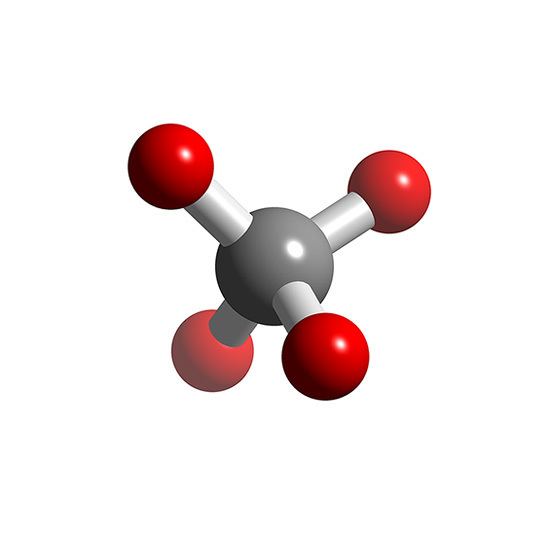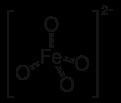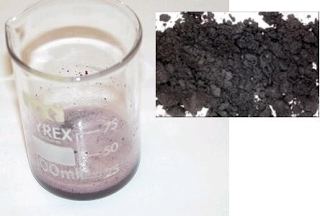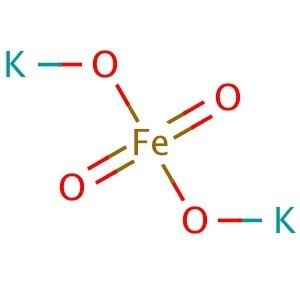Formula FeO42- | ||
 | ||
Kaliumferrat vi potassium ferrate vi
Ferrate(VI) is the inorganic anion with the chemical formula [FeO4]2−. It is photosensitive, contributes a pale violet colour to compounds and solutions containing it and is one of the strongest water-stable oxidising species known. Although it is classified as a weak base, concentrated solutions containing ferrate(VI) are corrosive and attack the skin and are only stable at high pH.
Contents
- Kaliumferrat vi potassium ferrate vi
- 03 crude synthesis of a ferrate vi
- Nomenclature
- Synthesis
- Properties
- References

03 crude synthesis of a ferrate vi
Nomenclature

The term ferrate is normally used to mean ferrate(VI), although it can refer to other iron-containing anions, many of which are more commonly encountered than salts of [FeO4]2−. These include the highly reduced species disodium tetracarbonylferrate Na2[Fe(CO)4] and salts of the iron(III) complex tetrachloroferrate [FeCl4]−. Although rarely studied, ferrate(V) [FeO4]3− and ferrate(IV) [FeO4]4− oxyanions of iron also exist. These too are called ferrates.
Synthesis

Ferrate(VI) salts are formed by oxidizing iron in an aqueous medium with strong oxidizing agents under alkaline conditions, or in the solid state by heating a mixture of iron filings and powdered potassium nitrate.
For example, ferrates are produced by heating iron(III) hydroxide with sodium hypochlorite in alkaline solution:
2 Fe(OH)3 + 3 OCl−
+ 4 OH−
→ 2 [FeO
4]2−
+ 5 H
2O + 3 Cl−
The anion is typically precipitated as the barium(II) salt, forming barium ferrate.
Properties
The ferrate(VI) anion is unstable at neutral or acidic pH values, decomposing to iron(III):
[FeO4]2−
+ 3 e− + 8 H+
⇌ Fe3+
+ 4 H
2O
The reduction goes through intermediate species in which iron has oxidation states +5 and +4. These anions are even more reactive than ferrate(VI). In alkaline conditions ferrates are more stable, lasting for about 8 to 9 hours at pH 8 or 9.

Aqueous solutions of ferrates are pink when dilute, and deep red or purple at higher concentrations. The ferrate ion is a stronger oxidizing agent than permanganate, and will oxidize chromium(III) to dichromate, and ammonia to molecular nitrogen.
Ferrates are excellent disinfectants, and are capable of removing and destroying viruses.
The ferrate(VI) ion has two unpaired electrons, and is thus paramagnetic. It has a tetrahedral molecular geometry. Fe (VI) is a strong oxidizing agent over the entire pH range, with a reduction potential (Fe(VI)/Fe(III) couple) varying from +2.2 V to +0.7 V versus NHE in acidic and basic media respectively. Sodium ferrate (Na2FeO4)is a useful reagent with good selectivity and is stable in aqueous solution of high pH, remaining soluble in an aqueous solution saturated with sodium hydroxide. Iron usually exists in the +2 and +3 oxidation states; however, in a strong oxidizing environment, higher oxidation states of iron such as +4, +5 and +6 can also be obtained. Ferrate is one of the most powerful, yet environmentally friendly, water treatment chemicals known. The byproduct of ferrate oxidation is the relatively benign iron (III), or ferric oxide. Fe (III) occurs naturally in the human body and plant and animal forms. Ferrate is a tetrahedral ion isostructural with the chromate and permanganate ions.
Eo = +2.20 V + 8H++ 3e- Fe3+ + 4H2O (acidic medium) Eo = +0.72 V + 4H2O+ 3e- Fe(OH)3 + 5OH- (basic medium)